International Toy Fair Nuremberg 2009
Internationale Spielwarenmesse Nürnberg 2009
| x |
|
|
|
|
|
|
|
|
|
|
|
|
|
|
|
|
|
|
|
|
|
|
|
|
|
|
|
|
|
|
|
|
|
| Amigo |
|
| x |
|
|
|
|
|
|
|
|
|
|
|
|
|
|
|
|
|
|
|
|
|
|
|
|
|
|
|
|
|
|
|
|
|
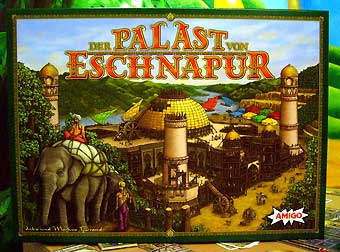 |
|
Building a palace is fine enough, but who does not want to help in building the famous palace of Eschnapur?
Each player has his own player board where he plays his construction and gold cards, and stores his bricks. The game goes in rounds, with each round having nine small phases. In phase one, players secretly place two building cards where they choose in which two sections they want to build this turn; in the next phase gold cards are allocated to the five clerks. These are also chosen secretly. |
|
| x |
|
|
|
|
|
|
|
|
|
|
|
|
|
|
|
|
|
|
|
|
|
|
|
|
|
|
|
|
|
|
|
|
|
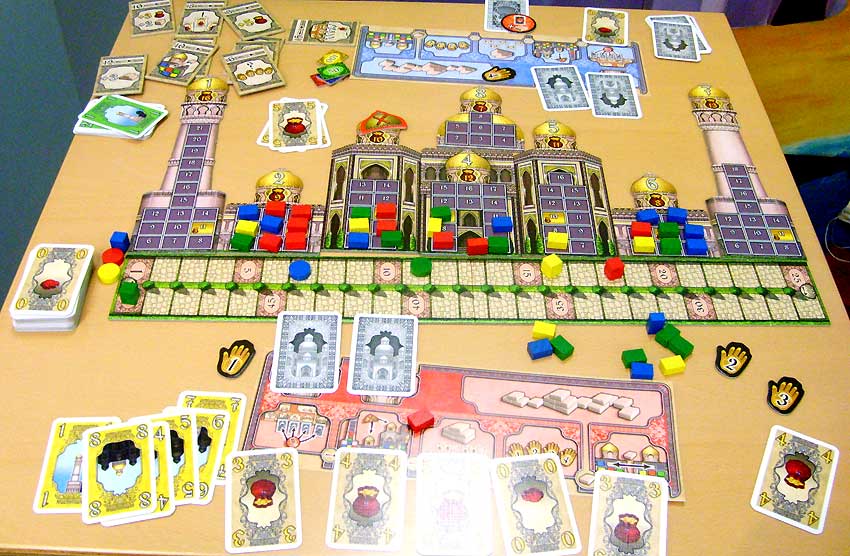 |
| x |
|
|
|
|
|
|
|
|
|
|
|
|
|
|
|
|
|
|
|
|
|
|
|
|
|
|
|
|
|
|
|
|
|
When this is done, players turn their leftmost card face up. Whoever played the highest gold card, get the block marker and immediately may use it to block any face down card of another player. This player cannot turn the card face up this round.
Then the secondmost left card is turned; the player who played the highest gold card, gains influence on the second clerk and gets the marker with which he can stop the construction of a palace section.
The third face up card has effect for all players. If only one player played a certain value gold card, he may take that amount in bricks; if there were more than one, the amount is halved.
The fourth card is to determine the player order; the player who wins this may determine the start player and further playing order. |
|
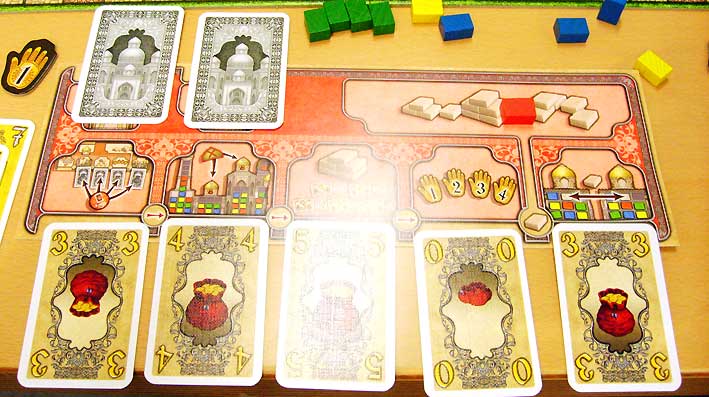 |
| x |
|
|
|
|
|
|
|
|
|
|
|
|
|
|
|
|
|
|
|
|
|
|
|
|
|
|
|
|
|
|
|
|
|
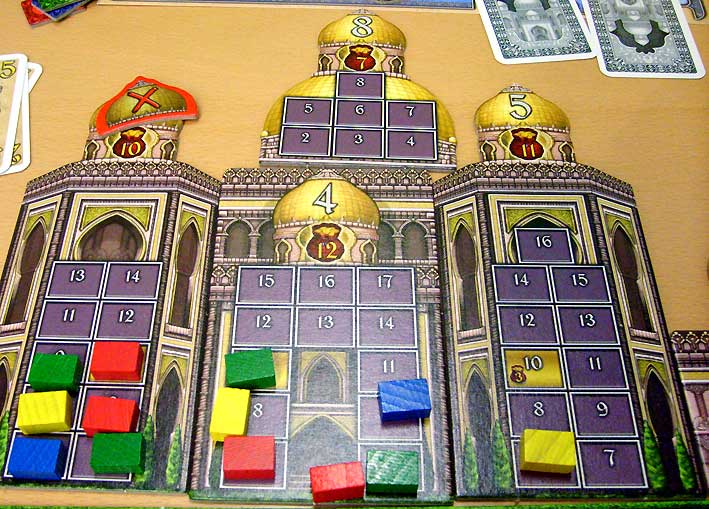 |
| x |
|
|
|
|
|
|
|
|
|
|
|
|
|
|
|
|
|
|
|
|
|
|
|
|
|
|
|
|
|
|
|
|
|
After this players get to build. When it is a players turn, he turns both construction cards face up and place his bricks, starting at the lowest floor. He must ploace all bricks from his supply. There are bonuses when placing a brick on a floor with a gold sign; all players who have bricks inthat section may take gold cards for a total value of three, in any demonination.
The last card uncovered determines who may move a brick, but a player may only take the highest brick from any section and place it on the lowest level of any other section, except the section that has the construction block marker on it.
Whenever a player was the one with the highest card, he removes this card. After each round each player has a maximum of four cards still on his player board: the biddings he did not win. The values of these cards are added, and the player scores for these - after this the cards are removed and turned to the bank.
When a section is complete, players get the amount of gold as stated on the section of the palace; they take the gold form the bank in any denomination. When there is not enough gold in the bank, a player only gets part or nothing, all according to the (in this phase very important!) player order.
Now the section is scored; each player scores for his highest level brick added with the amount of his bricks.
The game ends when the sixth section is completed, earlier in a two or three player game.
Der Palast von Eschnapur, Inka & Markus Brand, Amigo, 2009 - 3 to 4 players, 10 years and up, 60 minutes |
|
| x |
|
|
|
|
|
|
|
|
|
|
|
|
|
|
|
|
|
|
|
|
|
|
|
|
|
|
|
|
|
|
|
|
|
| x |
|
|
|
|
|
|
|
|
|
|
|
|
|
|
|
|
|
|
|
|
|
|
|
|
|
|
|
|
|
|
|
|
|
| x |
|
|
|
|
|
|
|
|
|
|
|
|
|
|
|
|
|
|
|
|
|
|
|
|
|
|
|
|
|
|
|
|
|
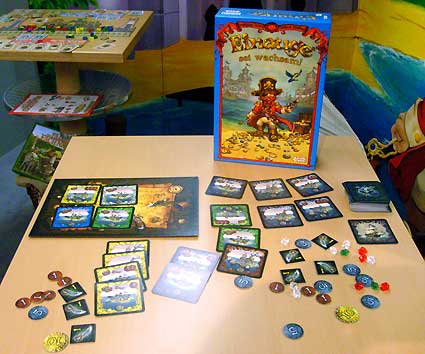 |
|
| x |
|
|
|
|
|
|
|
|
|
|
|
|
|
|
|
|
|
|
|
|
|
|
|
|
|
|
|
|
|
|
|
|
|
Players collect swords, ducats, chests and valuable jewels but have to watch out for pirate Einauge (One eye). With five players, all 56 island cards come into play. Six of them are turned face up and form a window. From the deck an island card is drawn and placed anywhere on Einauge's board.
There are eight islands, each of them in seven different costs and revenues.
During the game players collect islands and place them sorted by colour on the table. In a turn, a player must buy an island from the window; he may fight with Einauge for an island on his board; he must place a card from the window on Einauge's board; and he must take one or two cards from the deck and place them in the window.
The cost for an island card is stated on the bottom of the card; on the top what a player gets when he has bought it. A fight with Einauge costs 3 swords; when the island card shows a sword, the player must pay with 4 swords.
The game ends when one of the eight ship cards is drawn from the deck; scoring is done sequently: first the swords are exchanged into ducats, then ducats into jewels. Each island is scored separately: the player with most chests gets seven juwels, the second player four and the third one jewel.The player with the most jewels wins.
Einauge sei wachsam!, Wolfgang Kramer & Michael Kiesling, Amigo, 2009 - 2 to 5 players, 10 years and up, 30-45 minutes |
|
|
| x |
|
|
|
|
|
|
|
|
|
|
|
|
|
|
|
|
|
|
|
|
|
|
|
|
|
|
|
|
|
|
|
|
|
| x |
|
|
|
|
|
|
|
|
|
|
|
|
|
|
|
|
|
|
|
|
|
|
|
|
|
|
|
|
|
|
|
|
|
| x |
|
|
|
|
|
|
|
|
|
|
|
|
|
|
|
|
|
|
|
|
|
|
|
|
|
|
|
|
|
|
|
|
|
 |
|
At the stand this was the only information, with the note: 'Coming in Fall 2009'.
Atlantis - no further information |
|
| x |
|
|
|
|
|
|
|
|
|
|
|
|
|
|
|
|
|
|
|
|
|
|
|
|
|
|
|
|
|
|
|
|
|
| x |
|
|
|
|
|
|
|
|
|
|
|
|
|
|
|
|
|
|
|
|
|
|
|
|
|
|
|
|
|
|
|
|
|
| x |
|
|
|
|
|
|
|
|
|
|
|
|
|
|
|
|
|
|
|
|
|
|
|
|
|
|
|
|
|
|
 |
|
|
|
|
|
|
|
|
|
|
|
|
|
|
|
|
|
|
|
|
|
|
|
|
|
|
 |
|
|
|
|
|
|
|
|
|
|
|
|
|
|
|
|
|
|
|
|
|
|
|
|
|
|
 |
|
|
|
|
|
|
|
|
|
|
|
|
|
|
|
|
|
|
|
|
|
|
|
|
|
|
 |
|
|
|
|
|
|
|
|
|
|
|
|
|
|
|
|
|
|
|
|
|
|
|
|
|
|
 |
|
|
|
|
|
|
|
|
|
|
|
|
|
|
|
|
|
|
|
|
|
|
|
|
|
|
| x |
|
|
|
|
|
|
|
|
|
|
|
|
|
|
|
|
|
|
|
|
|
|
|
|
|
|
|
|
|
|
|
|
|
 |
|
|
|
|
|
|
|
|
|
|
|
|
|
|
|
|
|
|
|
|
|
|
|
|
|
|
|
|
|
|
|
|
|
|
|
|
|
|
|
|
|
|
|
|
|
|
|
|
|
|
|